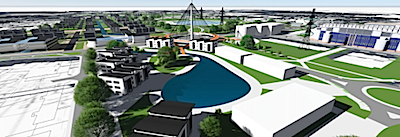Falkirk Council has unveiled plans to create a new, environmentally friendly urban quarter at the eastern entrance to Falkirk under its multi-million pound Tax Incremental Finance (TIF) initiative.
The proposed £17 million package of infrastructure works aims to stimulate a mix of business, learning and leisure development over 376 acres to regenerate a “gateway” entrance into Falkirk.
The plan also aims to create better connections between the town centre, Grangemouth and the rest of Scotland’s Central Belt.
The council’s vision for a new urban quarter was outlined in the latest TIF report presented to the Falkirk Council Executive.
The area takes in sites that include the Gateway, Falkirk Community Stadium, land earmarked for the new £70 million Forth Valley College campus and the home of the Kelpies sculptures.
Falkirk Council’s proposed plan aims to use low carbon technologies “to build a more sophisticated infrastructure across the area that will enable further development, support traffic flow and attract private investment.”
One feature of the plan will create the UK’s first circular elevated pedestrian and cycle crossing.
Funding from Falkirk Council’s £67 million TIF scheme and other external sources will fund the programme of infrastructure by borrowing against future business rate income expected to be generated by the resulting regeneration and development.
“The Gateway is a prime site to attract jobs, investment and development for our area,” said councillor Craig Martin, leader of Falkirk Council.
“With the huge and growing appeal of the Kelpies, the Community Stadium facility and the forthcoming college campus, there’s huge investment potential for developers across tourism, business and leisure.
“Through the Falkirk Tax Incremental Finance initiative, we have the lever to prepare the site for development and create the connections needed to support expected traffic flow and the footfall.
“The latest TIF report shows that we are making good progress with the initiative and will be launching further phases to improve access and support new development in Grangemouth.”
